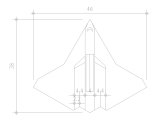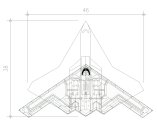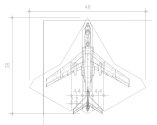Did I miss something? why are we considering a supersonic H-20 at all?In relation to a supersonic H-20, a poster found the design i was referring to that i couldn't find. IF the H-20 is indeed supersonic as recent rumours suggest, it MIGHT look like this.
Chengdu next gen combat aircraft (?J-36)
Have we seen this picture before? It's from (知乎). Right now, Im not sure where the article in the picture comes from, but it should be from an internal aviation journal or report. It mentions that CAC proposed the J-36 design concept as early as 2009. Then, some research institute, possibly...www.sinodefenceforum.com
You are using an out of date browser. It may not display this or other websites correctly.
You should upgrade or use an alternative browser.
You should upgrade or use an alternative browser.
H-20 bomber (with H-X, JH-XX)
- Thread starter Deino
- Start date
D-30KP-2 is an engine with a relatively high bypass ratio for a combat aircraft. It would make it harder to reduce RCS for stealth.Ayi and Orca agreed it is powered by 4 x D-30kp-2 engines.
I doubt they would use that engine for the H-20. Way more likely would be a version of WS-10 or WS-15 without afterburner.
I am assuming the H-20 will be a subsonic flying wing type.
Ha, I told you all that the H-20 will just be the next iteration of the H-6 bomber and yus all didn't believe meD-30KP-2 is an engine with a relatively high bypass ratio for a combat aircraft. It would make it harder to reduce RCS for stealth.
I doubt they would use that engine for the H-20. Way more likely would be a version of WS-10 or WS-15 without afterburner.
I am assuming the H-20 will be a subsonic flying wing type.
I think the WS-18 stuff is complete nonsense. I don't think you can put something with bypass ratio of that in H-20.D-30KP-2 is an engine with a relatively high bypass ratio for a combat aircraft. It would make it harder to reduce RCS for stealth.
I doubt they would use that engine for the H-20. Way more likely would be a version of WS-10 or WS-15 without afterburner.
I am assuming the H-20 will be a subsonic flying wing type.
And I have not seen anywhere where they said that.
I think either WS-10 or WS-15 is reasonable. If they want to do supersonic fly wing, then add in afterburner.
The best estimate for the B-21 Raiders engines are PW9000 medium bypass turbofans, while the diameter is unknown, it is suspected to use a the F135 for it's low pressure section and have a bypass ratio of 4:1. This was after many lessons learned from the B-2, where they were worried about engine stalls with a non linear intake, and were unwilling to attempt any more fuel efficient turbine given the technology at the time. WS-18 is not completely unreasonable, the D-30KP-2/3's are not impossible to fit into a flying wing configuration, and there have even been speculation that the B-21 could use PW1500 engines, which have a fan diameter of 74" or 1850mm, although take that with a huge amount of salt. My point being that medium bypass turbofans are not crazy at all. The Larger engines also offer greater fuel efficiencies, which are key for a subsonic long range bomber.I think the WS-18 stuff is complete nonsense. I don't think you can put something with bypass ratio of that in H-20.
And I have not seen anywhere where they said that.
I think either WS-10 or WS-15 is reasonable. If they want to do supersonic fly wing, then add in afterburner.
It would be the 'safe option' to use low bypass as China doesn't have much flying wing experience, but it would be completely foolish. The B-2s technology limitations were that it entered service nearly 40 years ago. Equipping China's next generation bomber that could be entering service 50 years after the B-2, yet following it's exact footsteps would be building weapons of the past not the future. That is how the Raider, despite being smaller in size, is estimated to have a much greater range than it's predecessor.
That is why I completely believe people like Orca, who have said previously that the H-20 would use an engine like the D-30KP2. Or an engine like the WS-18, with improved technologies to improve efficiency. Medium bypass is the right way to go.
Last edited:
@tphuang sir that paper was published in 2020.The best estimate for the B-21 Raiders engines are PW9000 medium bypass turbofans, while the diameter is unknown, it is suspected to use a the F135 for it's low pressure section and have a bypass ratio of 4:1. This was after many lessons learned from the B-2, where they were worried about engine stalls with a non linear intake, and were unwilling to attempt any more fuel efficient turbine given the technology at the time. WS-18 is not completely unreasonable, the D-30KP-2/3's are not impossible to fit into a flying wing configuration, and there have even been speculation that the B-21 could use PW1500 engines, which have a fan diameter of 74" or 1850mm, although take that with a huge amount of salt. My point being that medium bypass turbofans are not crazy at all. The Larger engines also offer greater fuel efficiencies, which are key for a subsonic long range bomber.
It would be the 'safe option' to use low bypass as China doesn't have much flying wing experience, but it would be completely foolish. The B-2s technology limitations were that it entered service nearly 40 years ago. Equipping China's next generation bomber that could be entering service 50 years after the B-2, yet following it's exact footsteps would be building weapons of the past not the future. That is how the Raider, despite being smaller in size, is estimated to have a much greater range than it's predecessor.
They were considering D-30KP-2/WS-18 at the beginning of the design. back then even WS-10 wasn't completed. and as per the source that has already been replaced with newer engines.
complete details of that paper.
To provide some context for the academic paper.
According to the original poster , roughly translated:
1. The general stats of the warplane mentioned in the paper (168-ton designed MTOW, 78.5-ton empty weight, 72.2-ton fuel weight, 17-ton+0.2-ton payload capacity with a combat radius of 4500 kilometers) looks to be close/roughly similar to that of the B-2 Spirit strategic bomber of the USAF.
2. The required bench thrust given in the paper is 114.22kN, but the warplane seems to already have a new, target engine (in the pipeline?).
3. According to the paper, the original engines slated for the warplane has a cruising fuel consumption rate of 0.7kg/(kgf·h), and the cruising fuel consumption rate of D-30KP-2/WS-18 officially given by Saturn NPO is 0.705kg/(kgf·h). Both engine models seem to be comparable to one another.
4. The new, target engines meant to replace the original engines are stated to have a cruising fuel consumption rate of 0.0679kg/(N·h), which is equal to 0.665kg/(kgf·h).
Possible objectives of the academic paper in question:
1. The warplane was to be powered by D-30KP-2/WS-18 at the beginning of the design, and they have already considered to replace them with new, target engines later on.
2. The paper discusses the methods of determining the performance parameters of the new, target engines without significantly altering the structure (of the warplane).
3. In fact, one major contribution of the paper is to explore the avenue of changing the engines without redesigning/reconfiguring the inlets and nozzles of the warplane.
Of course, we won't know whether said warplane subject in this academic paper is fictitious (for concept evaluation purposes only) or real (meant to represent actual plans to a certain degree).
The stats for the engine thrust and MTOW look rather... off, somehow.
in early 2023 we have seen IL-76 test bed flying with new medium bypass engines. could be WS-10 or WS-15 variant.
View attachment 140090
remember this flight in early 2023.. Engine dimension indicate medium bypass ratio engine. either WS-10 or WS-15 variant. China don't have any application for this type engine other than large stealth bomber like H-20 ..
This is all really great, although the paper doesn't specify the aircraft. A new medium bypass engine based on WS-10 or WS-15 technologies for it's core would certainly be much more efficient than any WS-18 or D-30 variant. It may be just a variant, but honestly I would like to believe it could be given a new number designation.@tphuang sir that paper was published in 2020.
They were considering D-30KP-2/WS-18 at the beginning of the design. back then even WS-10 wasn't completed. and as per the source that has already been replaced with newer engines.
complete details of that paper.
in early 2023 we have seen IL-76 test bed flying with new medium bypass engines. could be WS-10 or WS-15 variant.
yes. it make zero sense to use WS-18/D-30 variant in 2025 when you have better technology available and WS-18 also doesn't make sense economically. will take enormous efforts to bring back WS-18 into modern world. yes that engine is pretty old now.This is all really great, although the paper doesn't specify the aircraft. A new medium bypass engine based on WS-10 or WS-15 technologies for it's core would certainly be much more efficient than any WS-18 or D-30 variant. It may be just a variant, but honestly I would like to believe it could be given a new number designation.
that new medium bypass ratio engine indicate either WS-10 or WS-15 variant exclusively developed for H-20 bomber.
I'm starting to think whether a flying wing is the only way to design a sub-sonic stealth bomber. The long wing span of the B-2/B-21 gives the best lift to drag ratio but the same long wings are also structurally weak and spatially inefficient, which translates to more structural weight and less internal volume for fuel. The short fuselage also makes it difficult to store long weapons internally.
Other than the flying wing, we also have J-36's tailless double delta. J-36's swept angle is optimized for super cruise but if we reduce the sweep angle and make the crank more pronounced for vortex lift, it may also be possible to optimized the double delta for high sub-sonic. We lose a bit of aerodynamic efficiency and stealth, but we gain structural strength, internal volume and the ability to install a long weapons bay. According to my very unprofessional guesswork, it is possible to put 4x medium bypass engines (say about 1.4m fan diameter), a huge centerline weapons bay as well as a lot of wing area and fuel into an aircraft not much longer than the H-6. After reading the paper about the 6-engine monster, it becomes suspicious whether XAC is planning for something big.
Other than the flying wing, we also have J-36's tailless double delta. J-36's swept angle is optimized for super cruise but if we reduce the sweep angle and make the crank more pronounced for vortex lift, it may also be possible to optimized the double delta for high sub-sonic. We lose a bit of aerodynamic efficiency and stealth, but we gain structural strength, internal volume and the ability to install a long weapons bay. According to my very unprofessional guesswork, it is possible to put 4x medium bypass engines (say about 1.4m fan diameter), a huge centerline weapons bay as well as a lot of wing area and fuel into an aircraft not much longer than the H-6. After reading the paper about the 6-engine monster, it becomes suspicious whether XAC is planning for something big.
Attachments
No, it is not the only way.I'm starting to think whether a flying wing is the only way to design a sub-sonic stealth bomber.
But it is the most optimal one, all things considered.



